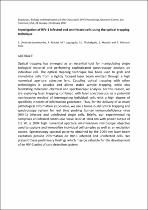 ResearchSpace
ResearchSpace
Investigation of HIV-1 infected and uninfected cells using the optical trapping technique
JavaScript is disabled for your browser. Some features of this site may not work without it.
- ResearchSpace
- →
- Research Publications/Outputs
- →
- Conference Publications
- →
- View Item
| dc.contributor.author |
Ombinda-Lemboumba, Saturnin

|
|
| dc.contributor.author |
Malabi, Rudzani

|
|
| dc.contributor.author |
Lugongolo, Masixole Y

|
|
| dc.contributor.author |
Thobakgale, Setumo L

|
|
| dc.contributor.author |
Manoto, Sello L

|
|
| dc.contributor.author |
Mthunzi-Kufa, Patience

|
|
| dc.date.accessioned | 2017-07-28T09:39:09Z | |
| dc.date.available | 2017-07-28T09:39:09Z | |
| dc.date.issued | 2017-02 | |
| dc.identifier.citation | Ombinda-Lemboumba, S., Malabi, R., Lugongolo, M.Y. et al. 2017. Investigation of HIV-1 infected and uninfected cells using the optical trapping technique. Biophysics, Biology and Biophotonics II: the Crossroads. SPIE Proceedings, Moscone Centre, San Francisco, USA, 28 January-3 February 2017. doi: 10.1117/12.2252294 | en_US |
| dc.identifier.isbn | 9781510605916 | |
| dc.identifier.uri | doi: 10.1117/12.2252294 | |
| dc.identifier.uri | http://proceedings.spiedigitallibrary.org/proceeding.aspx?articleid=2606583 | |
| dc.identifier.uri | http://hdl.handle.net/10204/9434 | |
| dc.description | Copyright: 2017 SPIE Digital Library. Due to copyright restrictions, the attached PDF file only contains the abstract of the full text item. For access to the full text item, kindly consult the publisher's website. | en_US |
| dc.description.abstract | Optical trapping has emerged as an essential tool for manipulating single biological material and performing sophisticated spectroscopy analysis on individual cell. The optical trapping technique has been used to grab and immobilize cells from a tightly focused laser beam emitted through a high numerical aperture objective lens. Coupling optical trapping with other technologies is possible and allows stable sample trapping, while also facilitating molecular, chemical and spectroscopic analysis. For this reason, we are exploring laser trapping combined with laser spectroscopy as a potential non-invasive method of interrogating individual cells with a high degree of specificity in terms of information generated. Thus, for the delivery of as much pathological information as possible, we use a home-build optical trapping and spectroscopy system for real time probing human immunodeficiency virus (HIV-1) infected and uninfected single cells. Briefly, our experimental rig comprises an infrared continuous wave laser at 1064 nm with power output of 1.5 W, a 100X high numerical aperture oil-immersion microscope objective used to capture and immobilise individual cell samples as well as an excitation source. Spectroscopy spectral patterns obtained by the 1064 nm laser beam excitation provide information on HIV-1 infected and uninfected cells. We present these preliminary findings which may be valuable for the development of an HIV-1 point of care detection system. | en_US |
| dc.language.iso | en | en_US |
| dc.publisher | SPIE | en_US |
| dc.relation.ispartofseries | Worklist;18553 | |
| dc.subject | Laser spectroscopy | en_US |
| dc.subject | Optical trapping | en_US |
| dc.subject | HIV-1 infection | en_US |
| dc.subject | Mammalian cells | en_US |
| dc.subject | Label-free detection | en_US |
| dc.title | Investigation of HIV-1 infected and uninfected cells using the optical trapping technique | en_US |
| dc.type | Conference Presentation | en_US |
| dc.identifier.apacitation | Ombinda-Lemboumba, S., Malabi, R., Lugongolo, M. Y., Thobakgale, S. L., Manoto, S. L., & Mthunzi-Kufa, P. (2017). Investigation of HIV-1 infected and uninfected cells using the optical trapping technique. SPIE. http://hdl.handle.net/10204/9434 | en_ZA |
| dc.identifier.chicagocitation | Ombinda-Lemboumba, Saturnin, Rudzani Malabi, Masixole Y Lugongolo, Setumo L Thobakgale, Sello L Manoto, and Patience Mthunzi-Kufa. "Investigation of HIV-1 infected and uninfected cells using the optical trapping technique." (2017): http://hdl.handle.net/10204/9434 | en_ZA |
| dc.identifier.vancouvercitation | Ombinda-Lemboumba S, Malabi R, Lugongolo MY, Thobakgale SL, Manoto SL, Mthunzi-Kufa P, Investigation of HIV-1 infected and uninfected cells using the optical trapping technique; SPIE; 2017. http://hdl.handle.net/10204/9434 . | en_ZA |
| dc.identifier.ris | TY - Conference Presentation AU - Ombinda-Lemboumba, Saturnin AU - Malabi, Rudzani AU - Lugongolo, Masixole Y AU - Thobakgale, Setumo L AU - Manoto, Sello L AU - Mthunzi-Kufa, Patience AB - Optical trapping has emerged as an essential tool for manipulating single biological material and performing sophisticated spectroscopy analysis on individual cell. The optical trapping technique has been used to grab and immobilize cells from a tightly focused laser beam emitted through a high numerical aperture objective lens. Coupling optical trapping with other technologies is possible and allows stable sample trapping, while also facilitating molecular, chemical and spectroscopic analysis. For this reason, we are exploring laser trapping combined with laser spectroscopy as a potential non-invasive method of interrogating individual cells with a high degree of specificity in terms of information generated. Thus, for the delivery of as much pathological information as possible, we use a home-build optical trapping and spectroscopy system for real time probing human immunodeficiency virus (HIV-1) infected and uninfected single cells. Briefly, our experimental rig comprises an infrared continuous wave laser at 1064 nm with power output of 1.5 W, a 100X high numerical aperture oil-immersion microscope objective used to capture and immobilise individual cell samples as well as an excitation source. Spectroscopy spectral patterns obtained by the 1064 nm laser beam excitation provide information on HIV-1 infected and uninfected cells. We present these preliminary findings which may be valuable for the development of an HIV-1 point of care detection system. DA - 2017-02 DB - ResearchSpace DP - CSIR KW - Laser spectroscopy KW - Optical trapping KW - HIV-1 infection KW - Mammalian cells KW - Label-free detection LK - https://researchspace.csir.co.za PY - 2017 SM - 9781510605916 T1 - Investigation of HIV-1 infected and uninfected cells using the optical trapping technique TI - Investigation of HIV-1 infected and uninfected cells using the optical trapping technique UR - http://hdl.handle.net/10204/9434 ER - | en_ZA |





